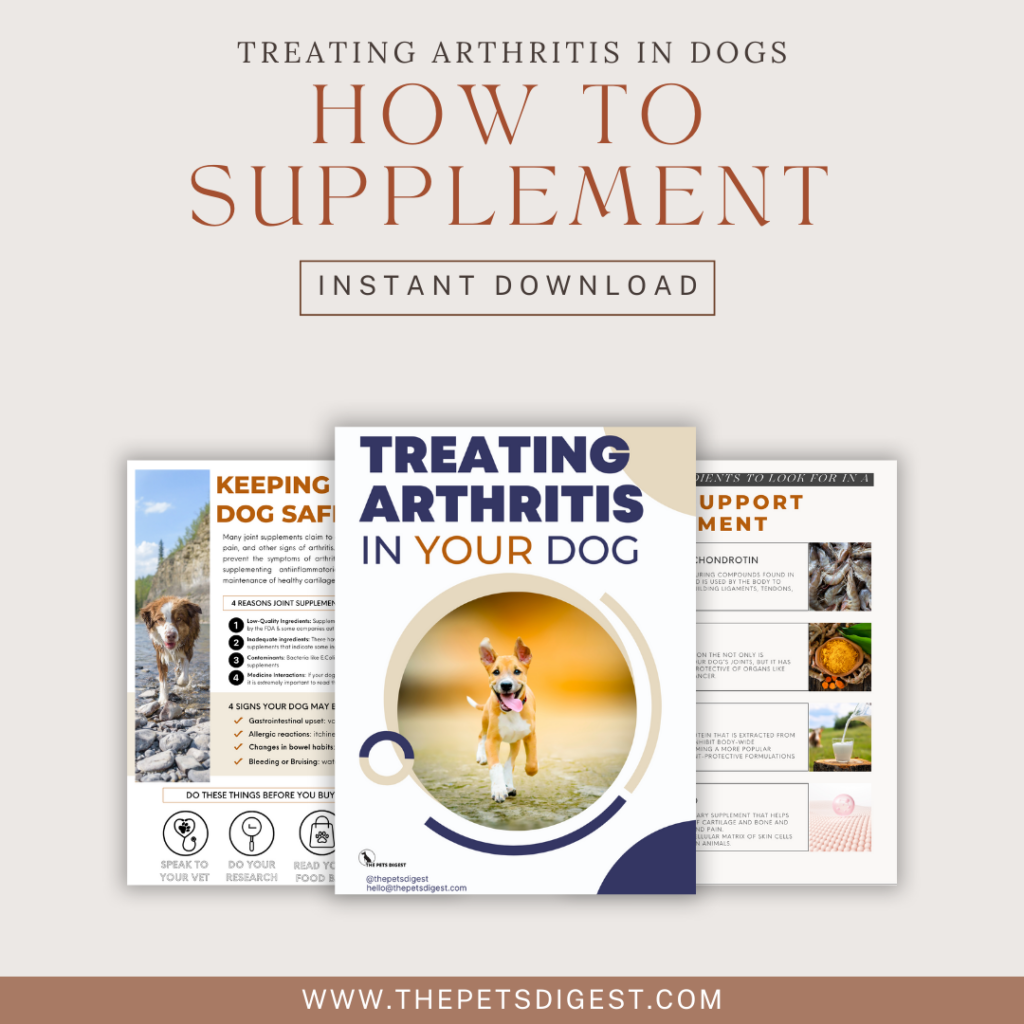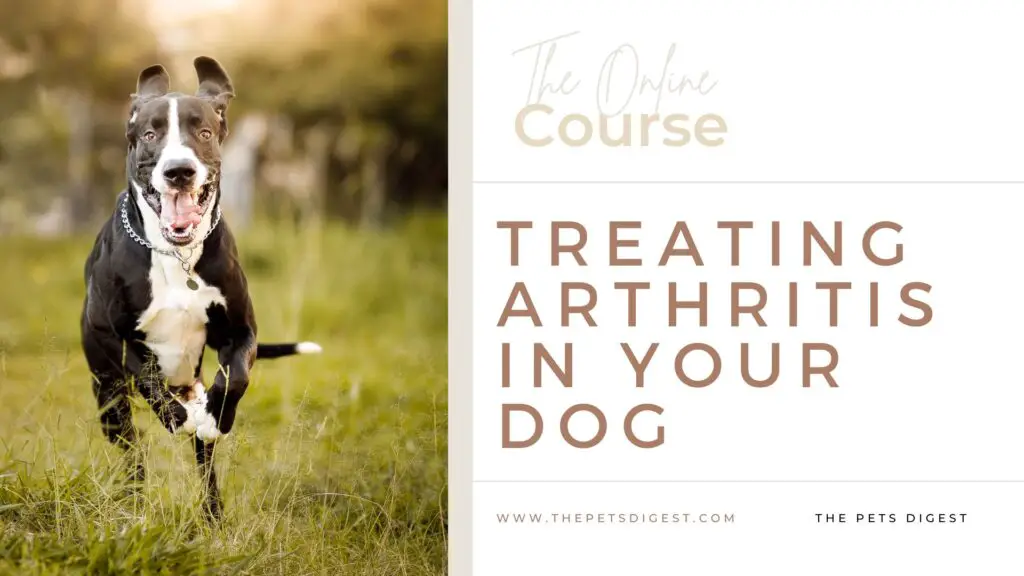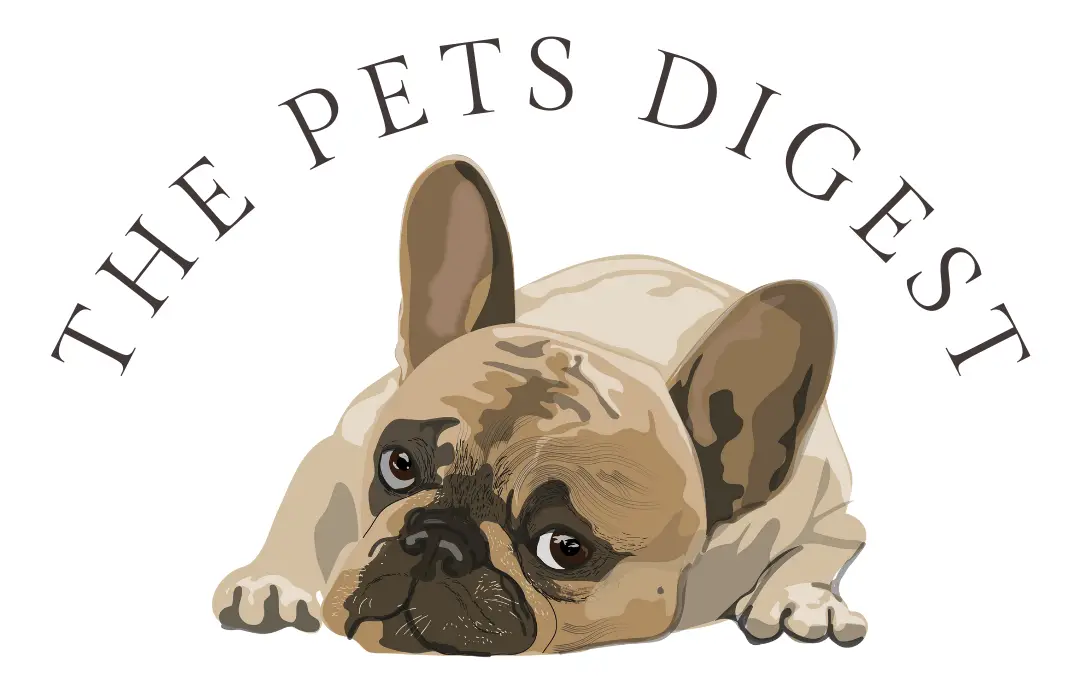Arthritis is the swelling and inflammation of your dog’s joints which can cause swelling, stiffness, and pain. There are different types of arthritis that dogs can acquire, let’s look at four of them.
Four types of arthritis in dogs

1. Osteoarthritis
Osteoarthritis also known as degenerative joint disease (DJD) is by far the most common type of arthritis seen in dogs.
While some breeds, like these, may acquire osteoarthritis more often than others, all dogs can get suffer from it.
Osteoarthritis is when the cartilage (the substance that acts as a cushion between the bones) breaks down and there is nothing to keep the bones from rubbing together.
This type of arthritis is sometimes called ‘wear and tear’ arthritis because it is the result of repeated use of the joints over time.
DJD can occur at any age but is mostly seen in older dogs as it usually occurs from injuries and wear and tear on the joints. It is estimated that around twenty percent of dogs will suffer from osteoarthritis but many vets believe the number may be even higher.
To read more about what dog breeds are more prone to acquiring osteoarthritis, read our latest blog post here.
2. Gout
Yes, although extremely rare, dogs can get gout!
It was once thought that non-human mammalians did not get gout but there have been cases of dogs acquiring the disease. Gout is a form of inflammatory arthritis that occurs when there is too much uric acid in the body.
3. Rheumatoid arthritis
Rheumatoid arthritis or RA is a type of immune-mediated developmental joint issue, meaning it is a disorder of the immune system and can begin developing at birth.
This means that there is a disconnect in your dog’s immune system and instead of protecting them the immune cells begin to attack areas of the body, in this case, the joints.
This leads to inflammation of several joints and can be quite painful.
Rheumatoid arthritis is also fairly uncommon in dogs, although more commonly seen than gout. The disease occurs in approximately 2 out of every 25,000 dogs whereas it is estimated that one out of every 5 dogs will suffer from the more common type of arthritis, DJD.
The disorder occurs mainly in toy or smaller breeds and can develop in puppies as young as eight months of age.
4. Septic
Septic arthritis is caused when an infectious agent like bacteria, usually Staphylococcus, invades the joints. This can lead to inflammation and pain.
Septic arthritis arises due to events like punctures, secondary to surgery, or as a result of a foreign body. This research paper discusses septic arthritis secondary to a foreign body puncture, a porcupine quill (Source).
Dogs that suffer from septic arthritis usually show symptoms that include swelling of the area, redness, pain, and heat. In most cases, the dog will not want to eat or walk a lot and want to rest more than usual, they may also eventually form a fever.

5 Ways food can help arthritis in dogs

While there are several things you should do to help your dog if they have arthritis, one of the first things you should do is speak with your vet about their diet.
Diet plays such a big part in how your dog moves through the world, so it is no surprise that it can help improve arthritis as well.
1. Prevention
While you may not be able to completely prevent your dog from acquiring arthritis you can put the odds in their favor.
There are foods that may help decrease inflammation in the body overall and in turn help with keeping the pain of arthritis at bay for as long as possible. To read about more ways food may help prevent arthritis in dogs read our article here.
2. Feed a well-balanced meal
Feeding a high-quality diet will help by ensuring your dog gets the proper nutrients to function and grow properly. Many higher-quality diets include whole foods, nutraceuticals, and antioxidants.
3. Feed a joint-protective diet
If your dog has been diagnosed with arthritis your vet may want to place your dog on a joint-protective diet. There are many over-the-counter brands but some you will have to get a prescription from a vet to obtain.
4. Maintain a healthy weight
Refrain from feeding your dog things that can take them past their ideal body weight as this adds more pressure to the joints and could worsen their condition
5. Supplements
Including joint protective supplements is a common route for most pet owners. Supplements like glucosamine chondroitin, omega 3s, and MSM have been studied thoroughly for their positive impact on joint health in both humans and dogs
Other things you can do to help your dog with arthritis
Aside from shifting your dog’s diet to a joint-friendly one, there are many other things you can do as well
- Because arthritis is something that can develop secondary to issues like dysplasia (hip or elbow usually) and joint instability it is important to recognize these issues in dogs as early as possible to treat these processes early.
- Some owners have noticed improvements with nontraditional and naturopathic techniques like acupuncture, massage, shockwave treatment, stem cell therapy, shockwave treatment, and laser therapy
- If you are purchasing your dog from a breeder it is important to get as much background information as possible about the parents of your puppy. Ask if they have a history of any joint issues, dysplasias, or other disorders so you can be prepared in the future.
- Raise your dog’s food bowl so that it is more comfortable for them to eat, especially if they are a larger breed
- Use an orthopedic bed to keep your dog comfy. This is especially needed for larger dogs as the beds help to provide additional support that is needed while sleeping.
- If your dog has a hard time getting around you may need to incorporate items to assist them like ramps, nonskid padding on the floors, and a walking harness.
- Hydrotherapy seems to be helpful for many dogs, there are some vet clinics that have hydrotherapy pools available specifically for this purpose. Alternatively, you can take your dog swimming for low-impact exercise.
- Take your dog for several short walks throughout the day instead of lengthy ones. Dogs with arthritis still need exercise but keep it low-impact.
- Of course, you should speak with your veterinarian about surgical options if needed and medications that may be beneficial for your dog, this could include oral pain medication or injections that promote cartilage repair and discourage further breakdown

Other articles about joint health and diet
References
Gout in dogs: https://www.ncbi.nlm.nih.gov/pmc/articles/PMC9087635/
Septic arthritis in dogs: https://onlinelibrary.wiley.com/doi/abs/10.1111/j.1751-0813.1999.tb11708.x

























































































































